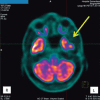Sport-related concussions
- PMID: 29213874
- PMCID: PMC5619443
- DOI: 10.1590/S1980-57642014DN81000003
Sport-related concussions
Abstract
Traumatic brain injury (TBI) is a major cause of lifelong disability and death worldwide. Sport-related traumatic brain injury is an important public health concern. The purpose of this review was to highlight the importance of sport-related concussions. Concussion refers to a transient alteration in consciousness induced by external biomechanical forces transmitted directly or indirectly to the brain. It is a common, although most likely underreported, condition. Contact sports such as American football, rugby, soccer, boxing, basketball and hockey are associated with a relatively high prevalence of concussion. Various factors may be associated with a greater risk of sport-related concussion, such as age, sex, sport played, level of sport played and equipment used. Physical complaints (headache, fatigue, dizziness), behavioral changes (depression, anxiety, irritability) and cognitive impairment are very common after a concussion. The risk of premature return to activities includes the prolongation of post-concussive symptoms and increased risk of concussion recurrence.
O traumatismo cranioencefálico (TCE) é uma das principais causas de deficiência ao longo da vida e de morte no mundo. As lesões cerebrais traumáticas relacionadas ao esporte são um problema de saúde pública de grande impacto. O intuito desta revisão foi expor a importância das concussões relacionadas ao esporte. A concussão é uma alteração transitória da consciência induzida por forças biomecânicas externas que podem ser direta ou indiretamente transmitidas ao cérebro. Sua ocorrência é comum, mas provavelmente é subnotificada. Esportes de contato, como futebol americano, rugby, futebol, boxe, basquetebol e hóquei, estão associados a uma prevalência relativamente alta de concussão. Diferentes fatores podem estar associados a um maior risco de concussão relacionada ao esporte, como idade, sexo, esporte jogado, categoria de esporte jogado e equipamentos utilizados. Queixas físicas (dores de cabeça, fadiga, tonturas), alterações comportamentais (depressão, ansiedade, irritabilidade) e comprometimento cognitivo são muito comuns após uma concussão. O risco de retorno prematuro às atividades inclui o prolongamento dos sintomas pós-concussionais e o aumento do risco de recorrência de concussão.
Keywords: TBI; concussion; sports; traumatic brain injury.
Figures
References
-
- Jang SH. Review of motor recovery in patients with traumatic brain injury. Neuro Rehabilitation. 2009;24:349–353. - PubMed
-
- Quevedo MJ. Internações em UTI por trauma cranioencefálico (TCE) na cidade de Porto Alegre. Porto Alegre: Escola de Enfermagem da Universidade Federal; Rio Grande do Sul: 2009. Monografia apresentada à. para obtenção do título de especialista em Saúde Pública.
-
- Langlois JA, Rutland-Brown W, Wald MM. The epidemiology and impact of traumatic brain injury: a brief overview. J Head Trauma Rehabil. 2006;21:375–378. - PubMed
-
- Jordan BD. The clinical spectrum of sport-related traumatic brain injury. Nat Rev Neurol. 2013;9:222–230. - PubMed
Publication types
LinkOut - more resources
Full Text Sources
Other Literature Sources



